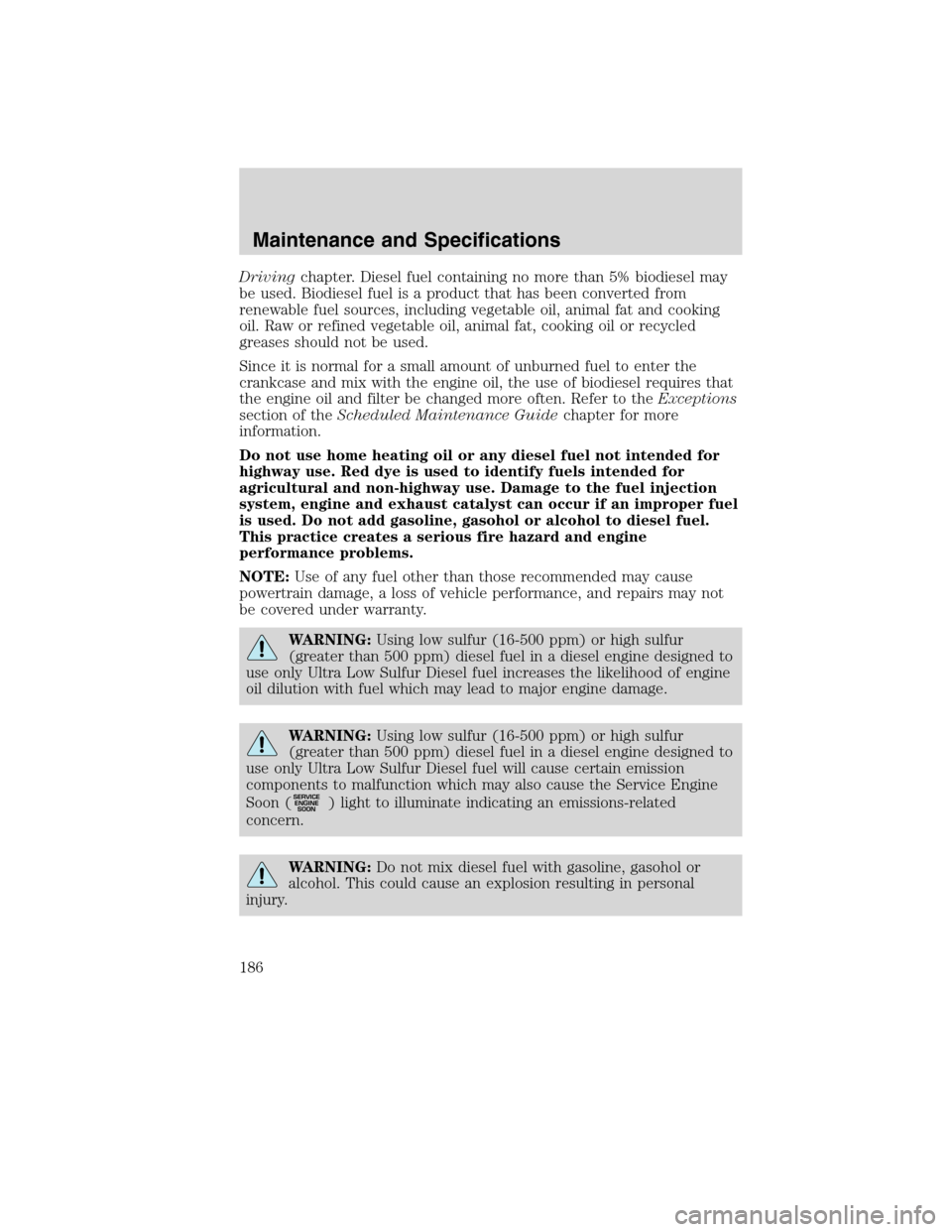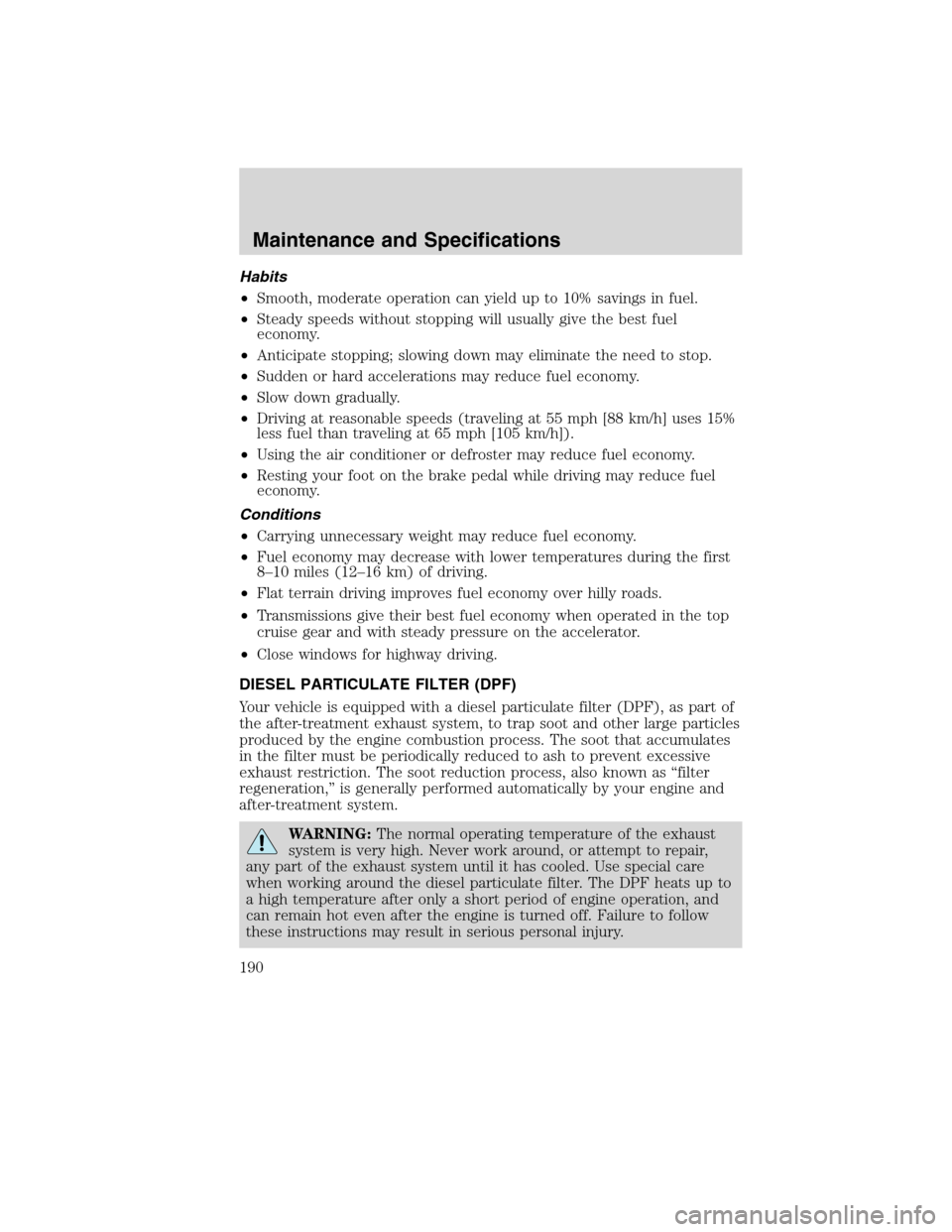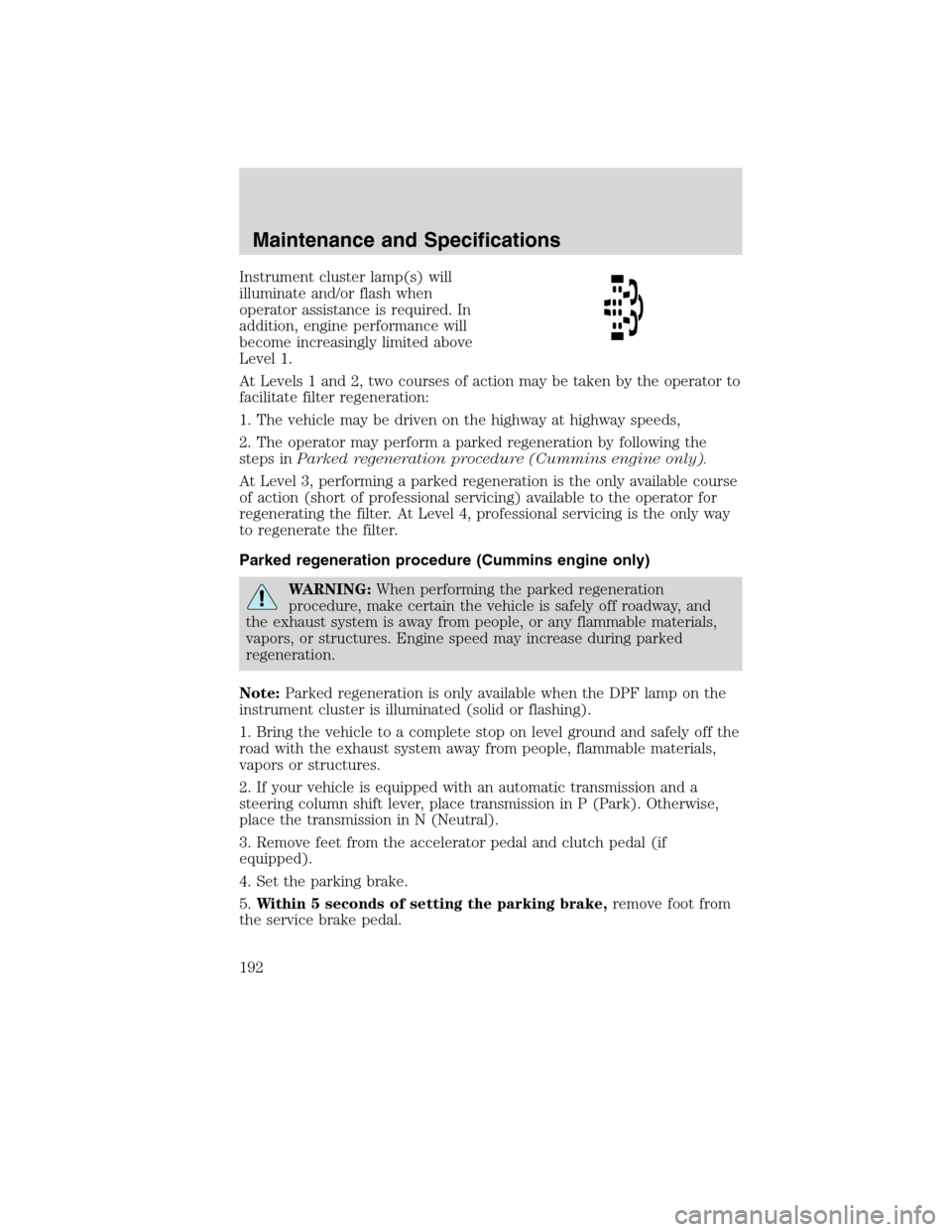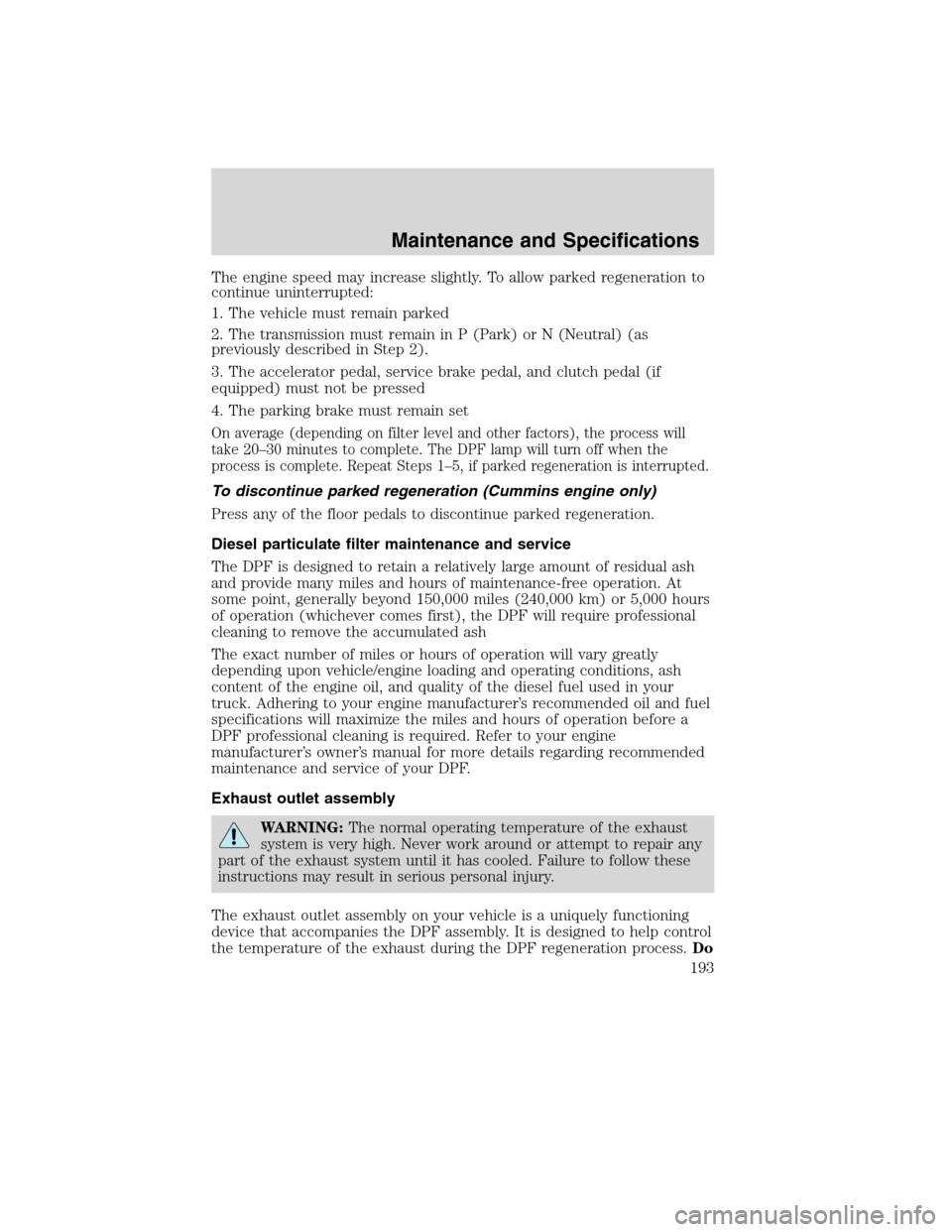2010 FORD F750 Filter
[x] Cancel search: FilterPage 186 of 274

Drivingchapter. Diesel fuel containing no more than 5% biodiesel may
be used. Biodiesel fuel is a product that has been converted from
renewable fuel sources, including vegetable oil, animal fat and cooking
oil. Raw or refined vegetable oil, animal fat, cooking oil or recycled
greases should not be used.
Since it is normal for a small amount of unburned fuel to enter the
crankcase and mix with the engine oil, the use of biodiesel requires that
the engine oil and filter be changed more often. Refer to theExceptions
section of theScheduled Maintenance Guidechapter for more
information.
Do not use home heating oil or any diesel fuel not intended for
highway use. Red dye is used to identify fuels intended for
agricultural and non-highway use. Damage to the fuel injection
system, engine and exhaust catalyst can occur if an improper fuel
is used. Do not add gasoline, gasohol or alcohol to diesel fuel.
This practice creates a serious fire hazard and engine
performance problems.
NOTE:Use of any fuel other than those recommended may cause
powertrain damage, a loss of vehicle performance, and repairs may not
be covered under warranty.
WARNING:Using low sulfur (16-500 ppm) or high sulfur
(greater than 500 ppm) diesel fuel in a diesel engine designed to
use only Ultra Low Sulfur Diesel fuel increases the likelihood of engine
oil dilution with fuel which may lead to major engine damage.
WARNING:Using low sulfur (16-500 ppm) or high sulfur
(greater than 500 ppm) diesel fuel in a diesel engine designed to
use only Ultra Low Sulfur Diesel fuel will cause certain emission
components to malfunction which may also cause the Service Engine
Soon (
SERVICE
ENGINE
SOON) light to illuminate indicating an emissions-related
concern.
WARNING:Do not mix diesel fuel with gasoline, gasohol or
alcohol. This could cause an explosion resulting in personal
injury.
Maintenance and Specifications
186
2010 F-650/750(f67)
Supplement(supplement), 1st Printing
USA(fus)
Page 190 of 274

Habits
•Smooth, moderate operation can yield up to 10% savings in fuel.
•Steady speeds without stopping will usually give the best fuel
economy.
•Anticipate stopping; slowing down may eliminate the need to stop.
•Sudden or hard accelerations may reduce fuel economy.
•Slow down gradually.
•Driving at reasonable speeds (traveling at 55 mph [88 km/h] uses 15%
less fuel than traveling at 65 mph [105 km/h]).
•Using the air conditioner or defroster may reduce fuel economy.
•Resting your foot on the brake pedal while driving may reduce fuel
economy.
Conditions
•Carrying unnecessary weight may reduce fuel economy.
•Fuel economy may decrease with lower temperatures during the first
8–10 miles (12–16 km) of driving.
•Flat terrain driving improves fuel economy over hilly roads.
•Transmissions give their best fuel economy when operated in the top
cruise gear and with steady pressure on the accelerator.
•Close windows for highway driving.
DIESEL PARTICULATE FILTER (DPF)
Your vehicle is equipped with a diesel particulate filter (DPF), as part of
the after-treatment exhaust system, to trap soot and other large particles
produced by the engine combustion process. The soot that accumulates
in the filter must be periodically reduced to ash to prevent excessive
exhaust restriction. The soot reduction process, also known as “filter
regeneration,” is generally performed automatically by your engine and
after-treatment system.
WARNING:The normal operating temperature of the exhaust
system is very high. Never work around, or attempt to repair,
any part of the exhaust system until it has cooled. Use special care
when working around the diesel particulate filter. The DPF heats up to
a high temperature after only a short period of engine operation, and
can remain hot even after the engine is turned off. Failure to follow
these instructions may result in serious personal injury.
Maintenance and Specifications
190
2010 F-650/750(f67)
Supplement(supplement), 1st Printing
USA(fus)
Page 191 of 274

Diesel particulate filter regeneration (Caterpillar engine only)
DPF regeneration requires no operator interaction and may occur at any
time. A small increase in engine sound-level during filter regeneration is
normal and should be no reason for concern.
A separate fuel injector/nozzle, which requires periodic cleaning, is used
in the regeneration process. Refer to Caterpillar’sOperation and
Maintenance Manualfor details regarding cleaning requirements.
Diesel particulate filter regeneration (Cummins engine only)
Under most operating conditions, DPF regeneration will be transparent
to the operator. A small increase in engine/turbo sound-level is normal
during filter regeneration. If, however, your engine is operated for
extended periods of time under one of the following conditions, operator
assistance may be required to facilitate the filter regeneration process:
•Vehicle is operated in stop-and-go traffic and/or maintains low speeds
as in a city/delivery driving
•Engine is started and shut-off frequently
•Vehicle payload is relatively light
•Vehicle is regularly operated in cold ambient temperatures (i.e. below
0°F [-18°C])
Diesel Particulate Filter Four–Level Loading Chart
Level/Lamp status Filter status Requested action
Level 1
DPF lamp solidRegeneration required. Drive on highway at
highway speedsOR
start “parked
regeneration” to
prevent loss of engine
performance. Level 2
DPF lamp flashing
(once per second)Nearly full. Engine
performance is limited.
Level 3
DPF lamp flashing +
Service Engine Soon
lamp solidFull. Engine is
increasingly limited.Perform “parked
regeneration” to
prevent loss of engine
performance.
Level 4
Stop Engine lamp
solidOver full. Engine
performance is highly
limited. Continued
operation may result
in irreparable damage
to the filter.Pull vehicle safely off
roadway, turn on
hazard flashers and
shut down engine as
soon as possible. Seek
service immediately.
Maintenance and Specifications
191
2010 F-650/750(f67)
Supplement(supplement), 1st Printing
USA(fus)
Page 192 of 274

Instrument cluster lamp(s) will
illuminate and/or flash when
operator assistance is required. In
addition, engine performance will
become increasingly limited above
Level 1.
At Levels 1 and 2, two courses of action may be taken by the operator to
facilitate filter regeneration:
1. The vehicle may be driven on the highway at highway speeds,
2. The operator may perform a parked regeneration by following the
steps inParked regeneration procedure (Cummins engine only).
At Level 3, performing a parked regeneration is the only available course
of action (short of professional servicing) available to the operator for
regenerating the filter. At Level 4, professional servicing is the only way
to regenerate the filter.
Parked regeneration procedure (Cummins engine only)
WARNING:When performing the parked regeneration
procedure, make certain the vehicle is safely off roadway, and
the exhaust system is away from people, or any flammable materials,
vapors, or structures. Engine speed may increase during parked
regeneration.
Note:Parked regeneration is only available when the DPF lamp on the
instrument cluster is illuminated (solid or flashing).
1. Bring the vehicle to a complete stop on level ground and safely off the
road with the exhaust system away from people, flammable materials,
vapors or structures.
2. If your vehicle is equipped with an automatic transmission and a
steering column shift lever, place transmission in P (Park). Otherwise,
place the transmission in N (Neutral).
3. Remove feet from the accelerator pedal and clutch pedal (if
equipped).
4. Set the parking brake.
5.Within 5 seconds of setting the parking brake,remove foot from
the service brake pedal.
Maintenance and Specifications
192
2010 F-650/750(f67)
Supplement(supplement), 1st Printing
USA(fus)
Page 193 of 274

The engine speed may increase slightly. To allow parked regeneration to
continue uninterrupted:
1. The vehicle must remain parked
2. The transmission must remain in P (Park) or N (Neutral) (as
previously described in Step 2).
3. The accelerator pedal, service brake pedal, and clutch pedal (if
equipped) must not be pressed
4. The parking brake must remain set
On average (depending on filter level and other factors), the process will
take 20–30 minutes to complete. The DPF lamp will turn off when the
process is complete. Repeat Steps 1–5, if parked regeneration is interrupted.
To discontinue parked regeneration (Cummins engine only)
Press any of the floor pedals to discontinue parked regeneration.
Diesel particulate filter maintenance and service
The DPF is designed to retain a relatively large amount of residual ash
and provide many miles and hours of maintenance-free operation. At
some point, generally beyond 150,000 miles (240,000 km) or 5,000 hours
of operation (whichever comes first), the DPF will require professional
cleaning to remove the accumulated ash
The exact number of miles or hours of operation will vary greatly
depending upon vehicle/engine loading and operating conditions, ash
content of the engine oil, and quality of the diesel fuel used in your
truck. Adhering to your engine manufacturer’s recommended oil and fuel
specifications will maximize the miles and hours of operation before a
DPF professional cleaning is required. Refer to your engine
manufacturer’s owner’s manual for more details regarding recommended
maintenance and service of your DPF.
Exhaust outlet assembly
WARNING:The normal operating temperature of the exhaust
system is very high. Never work around or attempt to repair any
part of the exhaust system until it has cooled. Failure to follow these
instructions may result in serious personal injury.
The exhaust outlet assembly on your vehicle is a uniquely functioning
device that accompanies the DPF assembly. It is designed to help control
the temperature of the exhaust during the DPF regeneration process.Do
Maintenance and Specifications
193
2010 F-650/750(f67)
Supplement(supplement), 1st Printing
USA(fus)
Page 243 of 274

Daily owner checks
EngineCheck the air filter restriction gauge.
Check the engine oil.
Inspect the coolant level
Brake systemCheck the air brake system reservoir
automatic drain valve operation.
Drain the air brake system reservoir -
manual valve.
Transmission systemVisually check the automatic
transmission for fluid leakage.
Steering systemCheck the power steering pump fluid
level and check the system for leaks.
Check the entire vehicle for evidence
of fluid leaks.
U.S. Department of
Transportation, Federal
Highway Administration
requirements (ensure that
the entire system is
functioning properly)Check the service brakes.
Check the parking brake.
Check the steering mechanism.
Check the lighting devices and
reflectors.
Check the tires.
Check the horn.
Check the windshield wipers.
Check the rear vision mirrors.
Check the wheels and rims.
Check the emergency equipment.
Scheduled Maintenance Guide
243
2010 F-650/750(f67)
Supplement(supplement), 1st Printing
USA(fus)
Page 246 of 274

Maintenance Operation Frequency - Observation
Check the engine performance
and the engine governorExcessive engine noise.
Inspect the fan, the fan shroud,
and the fan clutchEngine overheats, fan runs at high
speed constantly, excessive fan noise,
or fan wobble due to worn bearings.
Check for operation of ABS
warning lampAt each engine start up.
Inspect the entire exhaust
system (including inlet pipe,
muffler, outlet pipe and all
exhaust clamps and fasteners)
for holes, leakage, breakage,
looseness and corrosive
damageExcessive noise or the smell of fumes
is experienced.
Inspect the engine air
induction system (including the
air ducts and the air filter) for
loose fitting, damaged or
missing componentsExcessive noise emanates from the
engine compartment.
Inspect the tires and check the
air pressure
(3)Poor steering, wandering or excessive
tire wear.
Balance the wheels and the
tiresVibration or abnormal tire wear
indicates imbalance.
Check the front end alignment
(3)Poor steering, wandering or excessive
tire wear.
Check the transmission and
engine mountings
(2)Hard shifting or excessive vibration.
Check and adjust transmission
controls
(2)High effort to shift or noisy
transmission.
Check fuel pump pressure Insufficient full-throttle power or
backfiring.
Clean radiator cap seal. Clean
and inspect the cap surface on
the radiatorWhen the cap does not hold pressure.
Scheduled Maintenance Guide
246
2010 F-650/750(f67)
Supplement(supplement), 1st Printing
USA(fus)
Page 248 of 274

ON-HIGHWAY - 60,000 MILES (96,000 KM) OR MORE ANNUALLY
(Miles, kilometers or months - whichever occurs first)
Miles (x 1000) 15 30 45 60 75 90 105 120 135 150
Kilometers (x 1000) 24 48 72 96 120 144 168 192 216 240
Months 3 6 9 12 15 18 21 24 27 30
Non-driving front axle
Wheel bearing - oil type - check level••••••••••
Wheel bearing - oil type - change oil•
Wheel bearing - grease type - repack•••••
Tie rod ends - lubricate••••••••••
Drag link - lubricate••••••••••
King pin and bushing - lubricate••••••••••
Brake system - air
Slack adjusters - lubricate••
S-cam - lubricate••••••••••
Brake system - hydraulic
Master cylinder - check level••••••••••
Park brake relay lever / linkage - lubricate••
Steering
Power steering fluid - check level••••••••••
Power steering fluid - change fluid•
Power steering filter - replacement Five years or 500,000 miles (800,000 km)
Steering gear Ross TAS - output shaft - lubricate•••
Steering column u-joints / slip joint - lubricate••••••••••
Scheduled Maintenance Guide
248
2010 F-650/750(f67)
Supplement(supplement), 1st Printing
USA(fus)